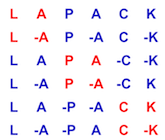 |
LAPACK 3.12.1
LAPACK: Linear Algebra PACKage
|
 |
LAPACK 3.12.1
LAPACK: Linear Algebra PACKage
|
| subroutine sgehd2 | ( | integer | n, |
| integer | ilo, | ||
| integer | ihi, | ||
| real, dimension( lda, * ) | a, | ||
| integer | lda, | ||
| real, dimension( * ) | tau, | ||
| real, dimension( * ) | work, | ||
| integer | info ) |
SGEHD2 reduces a general square matrix to upper Hessenberg form using an unblocked algorithm.
Download SGEHD2 + dependencies [TGZ] [ZIP] [TXT]
!> !> SGEHD2 reduces a real general matrix A to upper Hessenberg form H by !> an orthogonal similarity transformation: Q**T * A * Q = H . !>
| [in] | N | !> N is INTEGER !> The order of the matrix A. N >= 0. !> |
| [in] | ILO | !> ILO is INTEGER !> |
| [in] | IHI | !> IHI is INTEGER !> !> It is assumed that A is already upper triangular in rows !> and columns 1:ILO-1 and IHI+1:N. ILO and IHI are normally !> set by a previous call to SGEBAL; otherwise they should be !> set to 1 and N respectively. See Further Details. !> 1 <= ILO <= IHI <= max(1,N). !> |
| [in,out] | A | !> A is REAL array, dimension (LDA,N) !> On entry, the n by n general matrix to be reduced. !> On exit, the upper triangle and the first subdiagonal of A !> are overwritten with the upper Hessenberg matrix H, and the !> elements below the first subdiagonal, with the array TAU, !> represent the orthogonal matrix Q as a product of elementary !> reflectors. See Further Details. !> |
| [in] | LDA | !> LDA is INTEGER !> The leading dimension of the array A. LDA >= max(1,N). !> |
| [out] | TAU | !> TAU is REAL array, dimension (N-1) !> The scalar factors of the elementary reflectors (see Further !> Details). !> |
| [out] | WORK | !> WORK is REAL array, dimension (N) !> |
| [out] | INFO | !> INFO is INTEGER !> = 0: successful exit. !> < 0: if INFO = -i, the i-th argument had an illegal value. !> |
!> !> The matrix Q is represented as a product of (ihi-ilo) elementary !> reflectors !> !> Q = H(ilo) H(ilo+1) . . . H(ihi-1). !> !> Each H(i) has the form !> !> H(i) = I - tau * v * v**T !> !> where tau is a real scalar, and v is a real vector with !> v(1:i) = 0, v(i+1) = 1 and v(ihi+1:n) = 0; v(i+2:ihi) is stored on !> exit in A(i+2:ihi,i), and tau in TAU(i). !> !> The contents of A are illustrated by the following example, with !> n = 7, ilo = 2 and ihi = 6: !> !> on entry, on exit, !> !> ( a a a a a a a ) ( a a h h h h a ) !> ( a a a a a a ) ( a h h h h a ) !> ( a a a a a a ) ( h h h h h h ) !> ( a a a a a a ) ( v2 h h h h h ) !> ( a a a a a a ) ( v2 v3 h h h h ) !> ( a a a a a a ) ( v2 v3 v4 h h h ) !> ( a ) ( a ) !> !> where a denotes an element of the original matrix A, h denotes a !> modified element of the upper Hessenberg matrix H, and vi denotes an !> element of the vector defining H(i). !>
Definition at line 146 of file sgehd2.f.